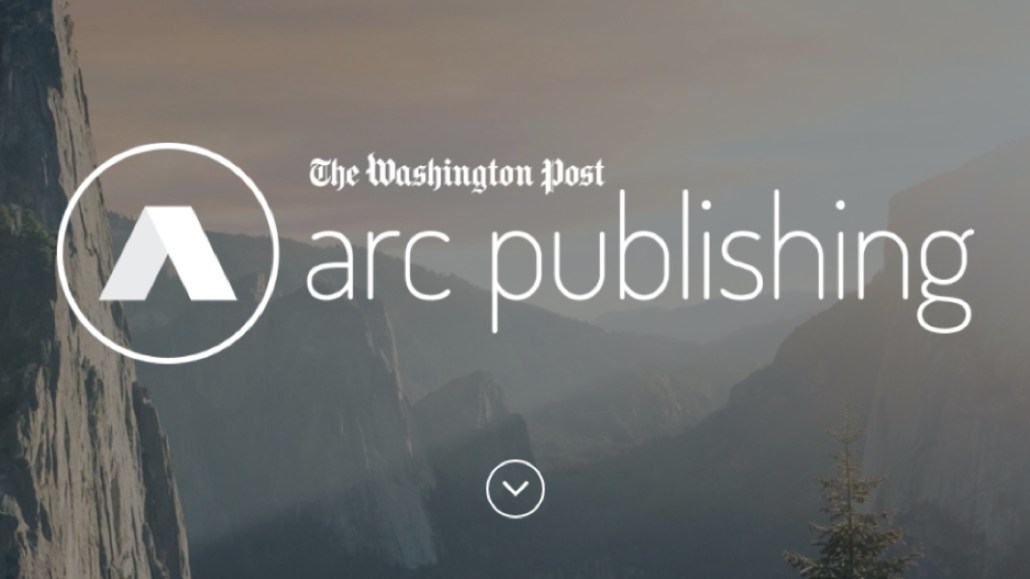
Arc, The Washington Post’s technology platform, is increasingly paying off for the newspaper company.
Arc has signed five major publishers as clients this year — Bonnier Corp., Advance Local, Boston Globe Media Partners, Philadelphia Media Network and Le Parisien. With those additions, Arc supports 90 sites and apps representing 500 million monthly unique visitors, the Post said. By year’s end, the figure will be between 150 and 200 sites, the Post said.
A company spokesman said Arc revenue has doubled over the past year, but declined to provide a raw dollar figure. Its clients’ fees range from $10,000 to $150,000 per month, depending on the amount of client content Arc hosts for them and processes it supports, and the Post sees Arc becoming a $100 million business. The Post-owned Arc is powered by Amazon Web Services, generating some nice synergies for Post owner and Amazon chief Jeff Bezos.
Arc has been catering to bigger clients since its start two years ago, adding features like personalization technology, video asset management to paywalls, and growing its staff to 150.
“As any product company, to some extent, offers professional services, we offer professional services as well,” said Scot Gillespie, The Washington Post’s chief technology officer. “For us to bring the platform to life in specific markets, we know that there’s value we can add by providing a service along with the product as well.”
Arc’s growth can be attributed to a few factors. It hired its first dedicated sales head in September, Clancy Ryan. Digital publishers’ needs are changing all the time, and few have the resources to keep up.
“A lot of publishers must do six or seven things very well to continue to grow,” said Tian Chen, the chief product officer of Philadelphia Media Network. “There aren’t many CMSes on the market that do this out of the box.”
Outsourcing its tech to Arc can free up a publisher’s resources, too. One team of Bonnier’s engineers, for example, spent most of their time supporting Sandcastle, its custom-built CMS. Arc also lets clients access third-party tools at lower prices thanks to Arc’s purchasing power, Gillespie said.
But implementing new digital infrastructure or support is an enormous hassle. Gillespie said it takes 6-12 months, on average, to migrate a client onto its system. Nearly two years after signing a preliminary agreement to explore how to use Arc, the newspaper publisher Tronc has migrated just two of its titles onto the platform. And as Arc has gone after larger clients with more varied collections of sites, the resources that Arc needs to integrate the product into clients’ systems have increased.
“We’re not going to commit to something we can’t deliver, just to win business,” Gillespie said. “If clients want us to do the onboarding, we have to make sure we have the staff to do it.”
Publishers have had a mixed track record licensing parts of their back end to peers. Purch, for example, generates more than 20 percent of its $120 million annual revenue by licensing its programmatic ad stack to more than two dozen publishers. On the other end of the spectrum, Forbes’s Falcon, the CMS that powers its contributor network, has been quiet for the past few years.
Gillespie said he has no concerns about licensing the technology to competitors. “I don’t think there’s anybody that’s off-limits,” Gillespie said.
But the company is also pitching Arc to non-publishing companies. Gillespie said Arc is in advanced discussions with multiple companies that create their own content for marketing and advertising.
Such a move opens up Arc to new clients but also new competitors. “I think they’re not just looking at other CMS businesses, but businesses like Contently,” said Ava Seave, a principal at the consultancy Quantum Media.
Seave said she thinks the Post will have to continue diversifying to broaden its client base to grow Arc. Meantime, publishers that become too dependent on the product’s suite of capabilities run a risk of their own.
“You have to worry about a powerful vendor,” Seave said. “If they get too powerful, they can charge you because you don’t want to change.”
Note: This story has been updated. An earlier version said Tronc had one title running on Arc. It has two.
More in Media

Digiday Scorecard: Publishers’ rate Big Tech’s AI licensing deals
Digiday has compiled a scorecard grading AI platforms to make sense of the growing number of players in the AI content licensing market.

Publishers are hunting for AI prompt data — now they’re starting to get it from third-party companies
Publishers are finally gaining some visibility into AI search, as new prompt data tools crack open a black box.

Digiday+ Research: Publishers’ growing focus on video doesn’t translate to social platforms
Major publishers have made recent investments in vertical video, but that shift is not carrying over to social media platforms.








